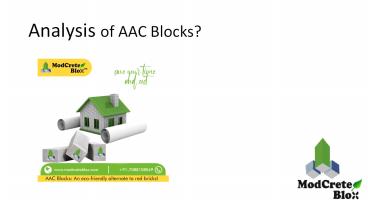Analysis of AAC Blocks - PowerPoint PPT Presentation
Title:
Analysis of AAC Blocks
Description:
Aerated Autoclaved Concrete (AAC) is made with no aggregates larger than sand, unlike most other concrete building applications in the construction industry. Coupling specialists include quartz sand, calcined gypsum, lime (mineral), concrete, and water. Fly debris from thermal power plants with a silica level of 50-65 percent is utilised as an aggregate in some countries, including India and China. AAC blocks are produced using a variety of raw materials. Flyash or sand is the primary ingredient in Aerated Autoclaved Concrete (AAC). Fly ash makes up 65-70 percent of the mixture, whereas coarse sand makes up 55-65%. Cement 53 GRADE OPC has a percentage proportion of 6-15 percent with Flyash and 10-20 percent with sand. – PowerPoint PPT presentation
Number of Views:24
Title: Analysis of AAC Blocks
1
Analysis of AAC Blocks?
2
Aerated Autoclaved Concrete (AAC) is made with no
aggregates larger than sand, unlike most other
concrete building applications in the
construction industry. Coupling specialists
include quartz sand, calcined gypsum, lime
(mineral), concrete, and water. Fly debris from
thermal power plants with a silica level of 50-65
percent is utilised as an aggregate in some
countries, including India and China. AAC blocks
are produced using a variety of raw materials.
Flyash or sand is the primary ingredient in
Aerated Autoclaved Concrete (AAC). Fly ash makes
up 65-70 percent of the mixture, whereas coarse
sand makes up 55-65. Cement 53 GRADE OPC has a
percentage proportion of 6-15 percent with Flyash
and 10-20 percent with sand.
3
When compared to other cement concrete materials,
autoclaved aerated concrete (AAC) has numerous
advantages. The primary benefit is that it is
both cost-effective and environmentally benign,
with minimal environmental impact. Because the
topsoil of the earth's surface is not used in the
production of AAC blocks, it emits extremely less
carbon dioxide when compared to red clay bricks.
Because AAC blocks are an industrial product made
with machines, the end product quality is
excellent, homogeneous, and consistent. Because
the blocks are even and perfectly finished on all
sides, the thickness of the wall plaster is
lowered. Because of its small weight, the
structural system will have less dead weight,
resulting in steel and concrete savings.
4
In today's construction sector, autoclaved
aerated concrete (AAC) is an unique and one of
the most acceptable and sustainable building
materials. As a result of the productive use of
recovered industrial waste, such as fly ash, AAC
blocks can be categorised as a sustainable
construction material. According to the rates in
India in 2019, the production price of AAC blocks
at the manufacturing plant ranges from Rs. 3200/-
to Rs. 3600/- per cubic metre. Because to the
inherent qualities of AAC blocks, construction
processes are quick and efficient. As a result,
autoclaved aerated concrete (AAC) has become an
efficient building construction material that is
used in a wide range of residential, commercial,
and industrial buildings. It has been used in the
Gulf countries for 40 years, Europe for 70 years,
and Australia and South America for 20 years.































